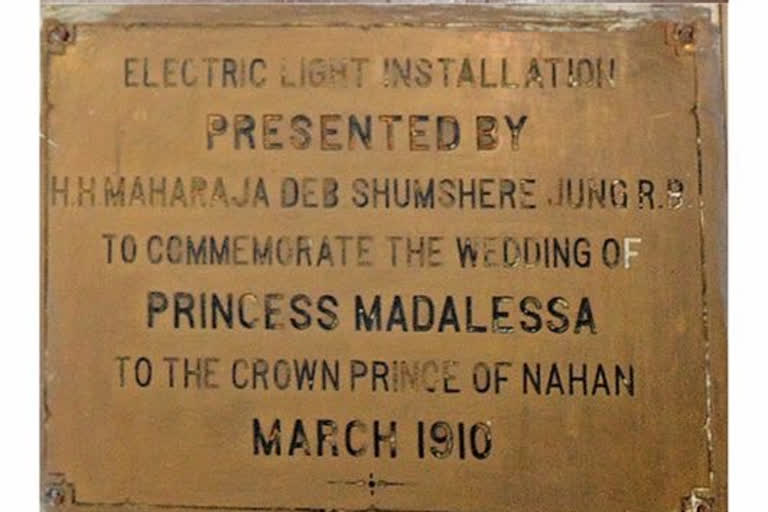New Delhi: A dusty old electric meter nailed to the wall of the Lodge in Dalhousie, Masonic Lodge, established in 1845. That was back in a time when the Nepalese Royals were yoked together by matrimony to the erstwhile rulers of India. This electric installation, if one were to go by the inscription on the brass plaque, was presented to the Lodge by ‘His Highness, Dev Shamsher Jung Bahadur Rana Junior to commemorate the wedding of Princess Madalessa to the Crown Prince of the Nahan in March 1910.’
On the ridge of Jharipani, southern extreme of the hill station, lie the ruins of a sprawling collection of grand buildings with crumbling gateways, arches, alcoves, doors and windows. Alongside are the railings with balusters made of solid lime and mortar, they are the sole reminders of Fairlawn Palace. It was not always so.
At least not when it was home to H.H. Dev S.J.B. Rana, who was Prime Minister of Nepal for three months before his brother ousted him in a coup. The East India Company did not want him in Darjeeling, it was temptingly close to the Nepalese border. He was offered two options: land in Delhi (what was later to become Connaught Place) or a place in the hills.
Between the two, he chose the latter. It must have been like the hill-and-mountain country he had left behind. Arrived, he chose a spot four miles along the old trail to Mussoorie. Well-seated on a ridge, with splendid views and a big garden and plentiful water. Thoughtfully they had brought everything they would need. Among these, the famous Naulakha haar – a necklace of multiple strings of pearls – taken from Nana Sahib when he sought refuge in Nepal in the aftermath of 1857 - it had been brought concealed in a bottle of mango pickle.
Years later, the estranged brothers, Dev and Chandra were fated to meet once again in Calcutta, where the following exchange is reported:
‘Your Highness,’ complained Chandra, ‘you escaped and tricked me of your person.’
‘Your Highness tricked me of my rightful kingdom!’ was Dev’s tit-for-tat.
In the Himalayan kingdom, the Ranas reigned as prime ministers having reduced their king to a figurehead. Of course, like most things, their rule too had to end, as matters came to a head on a crisp and cold winter morning on 6 November 1950, when King Tribhuvan’s motorcade set out with his family on what was ostensibly to be a picnic.
As they approached the gates of the Indian Embassy, the king glanced anxiously to the left. To his immense relief, he saw what he desperately hoped for… a predetermined signal from inside the compound. The vehicles veered suddenly to the left, and the gates were quickly slammed shut, with the guards finding themselves stranded outside.
Granted asylum, the king was flown to Delhi, a few days later and the movement of national liberation, meticulously planned by the Nepali Congress and others began. It was to spell the beginning of the end of Rana’s rule, when on 18th February 1951 (the seventh day of Falgun 2007 B.S.) King Tribhuvan ‘abrogated the 1846 treaty with Jung Bahadur Rana and declared that a republican constitution would be drafted by a constituent assembly.’
During their rule, the Ranas seemed to prefer marrying off their daughters into most of the leading ruling princely states of India including Kashmir, Baroda, Jaisalmer, Gwalior and Kathiawar (in the Kutch) up until Independence in 1947. This was a trend that lasted up to the time of the last Rana Prime Minister Mohan Shamsher SJB Rana, whose granddaughters were married to the ruling families of Kashmir, Jaisalmer and Jamnagar. But when the Rana men looked around for a match, a very few actually seemed to have married into what one could call mainline royalty in India. Instead, it seems that they sought to find marital matches from among the residents of the hills in Himachal.
Whilst in power, the Ranas encouraged the deposed Shah’s family to marry into the smaller princely families. Take, for example, Tribhuvan’s Shah’s second daughter, who was married into Mayurbhanj in Orissa and his other daughter was married to the Raja of Poonch in Kashmir.
Can any story on the marital bonds between the royals of Nepal and royals of India be complete without reference to Devyani Rana, she is the second daughter of Pashupati Shamsher Jang Bahadur Rana and Rani Usha Raje Scindia, daughter of Jivajirao Scindia, the last Maharaja of Gwalior.
At the dawn of the new millennium, rumours flew fast and furious, suggesting that the Crown Prince Dipendra of Nepal falling in love with her, wanted to marry her. But his parents, especially his mother, as well as Devyani's mother, were dead set against this union. The bond between the youngsters had formed while they were students in the United Kingdom. Queen Aishwarya Rajya Laxmi Devi Shah, was unhappy, and it is said she threatened to make the younger son the heir apparent.
It is widely believed that the refusal of the King and Queen to consent to their marriage had disastrous consequences. Things went horribly wrong, spiralling out of control leading to the unfortunate shoot-out which was to wipe out the Nepalese Royal family. Others insist that Crown Prince Dipendra may have had severe personality disorders that had not been attended to in time.
Later, in 2007, avoiding the media that had tagged her as the ‘Princess of Doom,’ Devyani married Kunwar Aishwarya Singh of Singrauli, a royal from the erstwhile state of Singrauli. He is the grandson of former Indian Human Resources Minister Arjun Singh, who in turn, belonged to the erstwhile state of Churhat.
India’s bahu-beti relations with the Himalayan kingdom are deep-rooted in history. Bloodlines have, for generations, met and mingled for the royals of Nepal and the erstwhile royal Houses of India.
